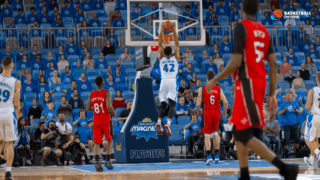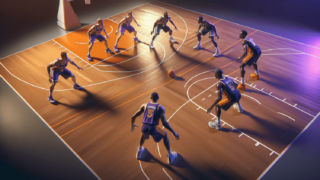
Welcome to our deep dive into the exhilarating world of running while dribbling a basketball! Perfecting this fundamental skill can set you up for remarkable success on the court, enabling you to elegantly weave through defenders like a seasoned pro. In this comprehensive guide, we’ll break down the techniques, tips, and tricks that will transform you into a dribbling maestro, all while keeping a fun and professional tone to ensure you enjoy the learning process. So, lace up your sneakers and get ready to level up your basketball game!
How to Run While Dribbling a Basketball
To run while dribbling a basketball, start by positioning your body in a low, athletic stance. Bend your knees and keep your back straight, while looking up at the court. Use your fingertips, not your palm, to maintain ball control as you dribble. Push the ball into the ground with a quick flick of your wrist, allowing the ball to bounce back up to you. To move forward, take a step with the same foot as your dribbling hand, keeping the ball slightly ahead of you. Consistently practice this technique to develop fluidity and make running while dribbling second nature.
The Art of Dribbling and Running in Basketball
Mastering the skill of running while dribbling the basketball opens up a world of opportunities in your gameplay. Let’s dive deep into various techniques and practices that will enhance your dribbling skills and take your game to the next level.
Fundamentals of Running with the Ball
Before we tackle dribbling specifics, it’s crucial to understand the basic movements and body posture that can significantly impact your overall performance on the court. By focusing on these foundational elements, running while dribbling becomes a breeze.
Proper Athletic Stance
Maintaining a proper athletic stance is the first step toward effective dribbling. When positioning your body in this stance, keep your feet shoulder-width apart, bend your knees, and maintain a slight forward lean, ensuring your back remains straight. Distribute your weight evenly across both feet, and make sure you stay on the balls of your feet, ready to spring into action.
Looking Up and Keeping an Eye on the Court
One common mistake beginners make when learning to dribble is continuously staring at the ball. Focus on looking up at the court instead, which enables you to assess the movement of your teammates and opponents. Improved court vision ensures enhanced gameplay and aids in making those snap decisions that can make or break a game of basketball.
Step by Step: Running While Dribbling a Basketball
Now that we’ve covered the essential body movements and postures let’s break down the process of running while dribbling a basketball. Remember to practice each step individually and then blend them together for a smooth and fluid motion.
Step 1: Hand Positioning and Ball Control
Control is key when dribbling a basketball. Maintain control by using your fingertips, not the palm of your hand. Additionally, spread your fingers comfortably apart for increased stability. This will help you to have a better feel of the ball and prevent it from bouncing out of your control.
Step 2: Pushing the Ball, Not Slapping It
Many new players fall into the habit of slapping the ball downward when dribbling. Instead, you should push the ball into the ground using a quick flick of your wrist, allowing it to bounce back up to your hand. This technique leads to a smoother dribble and keeps the ball under your control.
Step 3: Movement and Footwork
As you begin to move forward with the basketball, make sure to take a step with the same foot as your dribbling hand. Keep the ball slightly ahead of your body, making it more challenging for a defender to steal it. Continue alternating steps while maintaining control of the ball, and you’ll find yourself running while dribbling effortlessly!
Boosting Your Dribbling Speed
Once you’ve gotten the hang of running while dribbling at a comfortable pace, it’s time to amp up the speed. Let us explore various techniques designed to increase your dribbling speed while maintaining control of the basketball.
Get Comfortable with the Ball
The more time you spend with a basketball, the more comfortable you’ll become at controlling it. Practicing ball handling drills can increase your familiarity with the ball’s movement and weight, leading to a more confident dribbling style.
Strengthen Your Arm and Wrist
Wrist and arm strength play a significant role in upping your dribbling speed. By developing these muscles, you’ll be able to push the ball into the ground faster and increase the overall tempo of your dribble. Incorporate wrist curls and other arm exercises into your workout routine to build power and finesse.
Progressive Overload Drills
Pushing yourself slightly beyond your comfort zone is the key to boosting your dribbling speed. Set small, attainable goals for yourself, and gradually increase the difficulty or intensity of your dribbling drills. By continually challenging yourself, you’ll be able to develop a quicker and more dynamic dribbling style.
Enhancing Your Dribbling Technique
Now that you’ve learned the basics of running while dribbling and have begun working to increase your dribbling speed, it’s time to focus on enhancing your dribbling technique. The following drills and practices can be the catalyst in refining your skills and taking your basketball game to the next level.
Changing Direction While Dribbling
A key aspect of dribbling that warrants special attention is the ability to change direction at a moment’s notice, which can help you shake off defenders and create scoring opportunities. Practice techniques such as the crossover, behind-the-back dribble, and the spin move. By incorporating these moves into your repertoire, you’ll become a more unpredictable and challenging player to defend.
Master Different Dribbling Types
Diversify your dribbling by becoming adept at multiple types of dribbles. Add low dribbles, high dribbles, and hesitation dribbles to your skillset. In doing so, you’ll create a more versatile approach to running with the ball that can keep your opponents guessing.
Using Your Non-Dominant Hand
Developing your non-dominant hand is crucial for ambidextrous dribbling. By practicing ambidexterity, you’ll open up a whole new world of possibilities on the court. Work specifically on strengthening your non-dominant hand and incorporating it into your dribbling exercises to establish better control and agility.
Practice Makes Perfect
Perseverance, dedication, and practice are key components in becoming an expert dribbler. Keep honing your skills and remember that nothing beats spending time on the court with a basketball. Always challenge yourself to push the limits of your abilities, and watch as your game continues to soar to new heights!
Drills to Boost Your Running and Dribbling Skills
An essential step in becoming comfortable with running while dribbling a basketball is practicing specialized drills. These drills will help you solidify the lessons you’ve learned thus far while improving your hand-eye coordination, ball control, footwork, and reaction time. Let’s explore some of the most effective exercises to help you excel on the court.
Wall Taps and Dribbling
This drill is designed to improve ball control and awareness. Stand facing a wall, holding the basketball in your dominant hand. Dribble the ball while simultaneously tapping the wall rapidly with your non-dominant hand. Continue this process for 20-30 seconds and then switch hands. This exercise will help strengthen your off-hand and dribbling control, all while building your multitasking abilities.
The Zigzag Dribble
This exercise emphasizes changing direction while running and dribbling. Set up a series of cones or markers along the court in a zigzag pattern. Begin at the starting cone, and dribble the ball while weaving through the cones as quickly as you can. Remember to use direction-changing techniques like the crossover and behind-the-back dribble while navigating the obstacles. This drill teaches you how to maintain control while running and changing directions with the ball.
One-on-One Chase Challenge
Grab a partner and a basketball, and prepare to test your skills in this one-on-one chase challenge. The player in possession of the ball drives toward the basket while the other player chases and tries to catch up. This drill focuses on incorporating speed and dribbling skills to outpace your opponent. Swap roles frequently to invest time in both offensive and defensive skills.
Full-Court Dribble Relay
This drill focuses on running and dribbling at various speeds, which is an excellent way to build your stamina and develop your dribbling skills. Set up four markers along the length of the court. Dribble the basketball at different speeds as you make your way to each marker. Begin with a slow-paced dribble to the first marker, then switch to a medium pace to the second marker, and finally, sprint to the last marker while maintaining control. This drill teaches you how to change speed and paces while dribbling, simulating real-game scenarios.
Common Mistakes to Avoid While Running and Dribbling
As you progress and continue to practice your running and dribbling skills, it’s important to be aware of common mistakes that can hinder your development. Learn how to recognize and correct these errors to maximize your potential on the court.
Over-Dribbling
One common mistake novices make when running with the ball is over-dribbling. Excessive dribbling can slow down your movement on the court, making it easier for defenders to steal the basketball from you. Focus on dribbling just enough to retain control while allowing your momentum to propel you forward.
Failure to Protect the Ball
Not shielding the ball from defenders can leave you vulnerable to turnovers. When running, position your body between the defender and the ball. Use your off-hand and arm to create a barrier that makes it difficult for opponents to reach through, even as you maintain your dribble. This increases your ball retention and lowers the chances of an opponent stealing the ball from you.
Not Adapting to Defensive Pressure
As you progress in basketball, you’ll encounter varying levels of defensive pressure. Recognize the appropriate dribbling techniques needed to counteract tight or loose defensive coverage, and adjust your game accordingly. Knowing when to utilize low-dribbles, crossovers, or spin moves can be crucial when dealing with different defensive scenarios.
Using Your New Skills in Game Situations
Now that you’ve learned and practiced the art of running while dribbling, it’s time to put your skills to the test in real-game situations. As you gain experience, you’ll learn to apply your newly acquired abilities to break through defenses, create opportunities for your teammates, and become a formidable force on the court. So, get out there and let your skills shine. Remember, practice makes perfect, and the more you invest in your growth, the more impressive your basketball performance will become.
Frequently Asked Questions
As you develop your running and dribbling abilities, you may encounter questions or difficulties that require further clarification. Below, we address some of the most common questions asked by players who are striving to improve their dribbling game. Our goal is to provide clear and concise answers to help you on your journey to becoming a skilled dribbler.
1. What is the best way to maintain control while running and dribbling?
Using your fingertips instead of your palm will offer better ball control. Keep your hand on top of the ball and employ a quick flick of the wrist to push it into the ground, ensuring a smoother and more controlled dribble.
2. How can I improve my dribbling speed?
Improve your dribbling speed by strengthening your arm and wrist muscles, getting comfortable with the ball through practice, and employing progressive overload drills to incrementally challenge yourself.
3. How do I make my dribbling more versatile?
Becoming proficient in various dribbling types (low dribble, high dribble, and hesitation dribble) and direction-changing techniques (crossovers, behind-the-back dribbles, and spin moves) will enhance your versatility, making you a more formidable player on the court.
4. Why is it important to develop my non-dominant hand?
Developing your non-dominant hand enables you to dribble ambidextrously, which can make you more unpredictable and harder to defend. This will create additional scoring opportunities and enhance your overall basketball gameplay.
5. How can I change direction smoothly while dribbling and running?
Practice techniques such as the crossover, behind-the-back dribble, and the spin move to change direction fluidly. Incorporate these techniques into your dribbling drills so they become second nature during gameplay.
6. How often should I practice dribbling and running drills?
Consistent practice is key. Aim to practice at least 3-4 times per week or incorporate dribbling drills into your regular basketball practice to achieve noticeable improvements.
7. Can I practice dribbling and running indoors?
Yes, you can practice dribbling and running indoors as long as you have enough space to move safely. Ensure the floor isn’t slippery and choose a location with minimal furniture or obstacles to reduce the risk of injury.
8. What kind of shoes should I wear for dribbling and running practice?
Choose basketball-specific shoes that provide excellent traction, ankle support, and cushioning to reduce the risk of injury and to enhance your overall comfort during practice.
9. How important is my athletic stance when dribbling and running?
Having a proper athletic stance is crucial to maintain balance, agility, and control. Maintain a low, bent-knee stance with a straight back while looking up at the court, ensuring that your body is well-positioned for efficient dribbling and running.
10. How can I train myself not to look at the ball while I dribble?
Begin dribbling in place with your eyes closed to develop a feel for the ball. As you become more comfortable, try dribbling while walking and then running without looking down. Incorporate drills that require you to look up at the court to improve your court vision.
11. How do I break free from persistent defenders while running and dribbling?
Utilize a combination of dribbling techniques like direction-changing moves, speed changes, and protecting the ball with your body to escape persistent defenders and create more opportunities on the court.
12. What are some drills I can use to practice running and dribbling on my own?
Wall taps and dribbling, the zigzag dribble, and the full-court dribble relay are great solo drills you can practice. These exercises will help you enhance your ball control and handling skills while also focusing on speed, agility, and direction changes.
13. How do I maintain control of the ball while running at full speed?
To maintain control while running at full speed, use a combination of fingertip control and a quick flick of the wrist to push the ball into the ground. Keep the ball slightly ahead of your body and practice various dribbling drills at increasing speeds to develop your skill and precision.
Featured Posts
- No pillar pages found.





